-
Paper Information
- Paper Submission
-
Journal Information
- About This Journal
- Editorial Board
- Current Issue
- Archive
- Author Guidelines
- Contact Us
Education
p-ISSN: 2162-9463 e-ISSN: 2162-8467
2023; 13(1): 1-6
doi:10.5923/j.edu.20231301.01
Received: Jun. 10, 2023; Accepted: Jun. 26, 2023; Published: Jul. 12, 2023

Teenagers’ Education in Bangladesh with the View of Lower and Higher Secondary Education Scenario: A Socio-Economic Analysis
Soumen Kishor Nath1, Bishnu Kumar Adhikary2, Keya Rani Das3
1University of Chittagong, Institute of Education and Research (IER), Chittagong, Bangladesh
2University of Rajshahi, Institute of Education and Research (IER), Rajshahi, Bangladesh
3Bangabandhu Sheikh Mujibur Rahman Agricultural University, Department of Statistics, Faculty of Agricultural Economics and Rural Development, Gazipur, Bangladesh
Correspondence to: Bishnu Kumar Adhikary, University of Rajshahi, Institute of Education and Research (IER), Rajshahi, Bangladesh.
| Email: |  |
Copyright © 2023 The Author(s). Published by Scientific & Academic Publishing.
This work is licensed under the Creative Commons Attribution International License (CC BY).
http://creativecommons.org/licenses/by/4.0/

This study investigated the current state of teenagers education in Bangladesh from the perspective of lower and higher secondary education, specifically focusing on socioeconomic situations. According to UNICEF, students who attended lower and higher secondary schools between the ages of 13 and 19 are regarded as teens. On the basis of gender, residence location, and wealth conditions, data has been collected from the UNICEF website regarding enrollment rates and completion rates in the lower secondary level and higher secondary level from the years 2020–2022. The data analysis applied descriptive statistics. The results reveal that there are significantly fewer male students completing than there are enrolled students at both the lower and higher secondary levels. The number of female students who complete is also less than their enrollment rate. Results show that urban residents have better educational facilities and communications for teenagers in the upper secondary level. This study also reveals that, at the lower secondary level, the completion rate of the wealthiest students is higher than that of the poorest pupils. The completion rate of higher secondary education is higher for the wealthiest individuals than the poorest. Therefore, there is a highly favorable relationship between the socioeconomic impact and teenagers’ education in Bangladesh.
Keywords: Teenagers, Lower Secondary Education, Higher Secondary Education, Bangladesh
Cite this paper: Soumen Kishor Nath, Bishnu Kumar Adhikary, Keya Rani Das, Teenagers’ Education in Bangladesh with the View of Lower and Higher Secondary Education Scenario: A Socio-Economic Analysis, Education, Vol. 13 No. 1, 2023, pp. 1-6. doi: 10.5923/j.edu.20231301.01.
Article Outline
1. Introduction
- Teenage, which is considered by most to be between the ages of 13 and 19, is an essential formative stage that has an impact on both girls' and boys' lives. Since he was six years old and in late childhood, the young man has been a student. In Bangladesh, students typically start primary school when they are 6 years old or older (World Bank, 2015a). A child typically becomes a teenager at the age of 13 years. Children and teenagers between the years of 13 and 17 tend to be seen as separate divisions. Children who are between the age range of 18 and 19 are both teenagers and adults. Teenagers, adolescents, youths, or young adults are all terms that are used to refer to this generation, depending on the culture of the nation in issue. This study primarily used teenagers in this age range (Wikiwand, 2023). According to UNICEF, adolescents are those who are 13 to 19 years old. We know that, the UNICEF is the worldwide recognized organization for the child and teenagers. So, as the researchers we have taken UNICEF’s age range for the teenagers as standard. Although we assessed our data from UNICEF, we chose this age range for teenagers in lower and higher secondary education as our standard. Junior secondary education, as we refer to it here, begins at age of 11 years in accordance with the structure of the Bangladeshi educational system. Higher secondary education, or higher secondary education, as it is known here, begins at the age of 16. Here, secondary education is also a level that begins at the age of 14. So, the age range for this secondary education cycle is 11 to 17. (Ministry of Education, 2023; Ershad, A., & Subramanium, 2010).In Bangladesh, there are 13.7 million girls and 14 million boys aged 10 years to 19 years, making up a little over five percent of the overall population (UNICEF, 2017). Teenagers in Bangladesh typically join in secondary school till they are 11 years or older and continue when they are 16 years or older. Teenagers continued to live throughout such time when attending higher secondary schools (HSC). Higher secondary level is often continued when a student is 16 to 18 years old. They used to get one of three forms of schooling at this stage. Most of the Bangladeshi teenagers who attended secondary schools and universities obtain a general education. Some teenagers receive their education from the Madrashas, which primarily focuses on religious education. Teenagers who are financially stable and reside in cities are used to attending schools with an English medium. The Edexcell and Cambridge curricula are used in the English medium of instruction. On the other side, the National Curriculum and Textbook Board (NCTB) is followed by the General Medium Schools. Many teenagers have been found to be dropping out of school.When it comes to gender parity in enrollment, the difference is closing every day. In 1998, boys represented 52.2% of students and girls took up 47.8%. In 2001, boys took up 51% and girls comprised up 49%. However, this rate is favorable compared to the urban area (UNICEF, 2003). Approximately 30.7% of teenagers are not attending junior secondary school, according to UNICEF (UNICEF, 2014).On the other hand, according to (UNICEF, 2014), over 3 million teenagers have no prospect of receiving a secondary education. Among them boys than girls are out of school. They engage in a variety of income-generating activities the majority of the time. A great deal of teenagers appears to be striving financially to pay for their education. It was also found that sometimes they had to pay for extra books or private tuitions, amongst other indirect costs of education. In 2002, all female students received free tuition, a monthly stipend, book allowances, and examination expenses (for the junior secondary, secondary school, and higher secondary exams, among other exams). Recently, their mother's mobile banking system has been used to deposit the stipend money into her account (Financial Express, 2017). Some families believe that educating girls is unproductive and ineffective. As a result, girls in lower socioeconomic groups continue to be illiterate (Haq, 2007). In reality, most of the poorest families and rural communities are in this predicament. However, those who are financially solvent and reside in cities do not have these valid concerns. Parents exclusively provide their sons shelter in this mainly male only. However, educated families and higher-income groups do not exhibit this attitude. (Haq, 2007). As a result it is really urgent to find out the gap between number of enrollment and number of completion students in both lower secondary level and upper secondary level on the gender, residential area (rural and urban) and wealth variables. In this regard, our study examines the socioeconomic conditions of lower secondary education and higher secondary education to determine the current state of teenagers’ education.
1.1. Research Questions
- The aim of this study was to examine the current status of teenagers’ educational issues in the 2social and formal settings in Bangladesh. The research questions were:1. What is the current social-economical status of lower secondary education in Bangladesh?2. What is the present social-economical condition of the higher secondary education in Bangladesh?3. What is the scenario of the teenagers’ education in Bangladesh considering the lower and higher secondary education?
2. Significance of the Study
- The study was intended to make a significant contribution to our knowledge of the educational challenges facing Bangladeshi teenagers in the present day's social and economic context. The study illuminates the current wave of teenagers' social and economic status in education, which is useful for policymakers, especially the government of Bangladesh, development partners, and educationists. This research will demonstrate how the current social and economic context produces and losses educational opportunities for teenagers. Therefore, they will implement corrective measures by making decisions and taking action about the education of teenagers.
3. Methodology
- The study was quantitative approach by nature in order its research questions. Only quantitative data have been collected for this study. For gathering data and information properly, a rigorous literature review was done. With the focused of literature review, secondary data had been collected from UNICEF website from the UNICEF Global database on adjusted net attendance rate and completion rate which last updated on May 2022. Descriptive statistics with related graphical presentations were done here. Here, net attendance means the percentage of a school overall population that are physically present on the given year or day in the particular education level. Here also, completion means who have completed their lower secondary and Higher Secondary level of education on the given day or year in the particular education level. The completion percentages have been analyzed from the percentages of enrolled students of the lower secondary and upper secondary education level in the same residential area (rural and urban), gender and wealth categories.
4. Data Analysis
- The data of Lower Secondary and Higher Secondary level education are given bellow.
 | Figure 1. Gender wise ratio in the lower secondary level education |
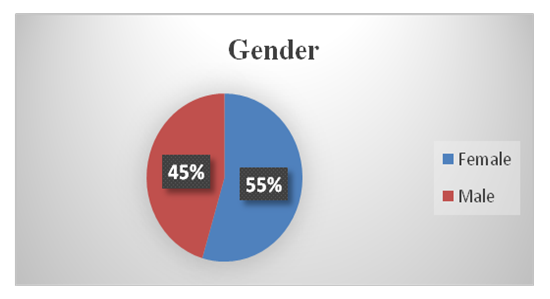 | Figure 2. Gender wise ratio of the completed lower secondary level education |
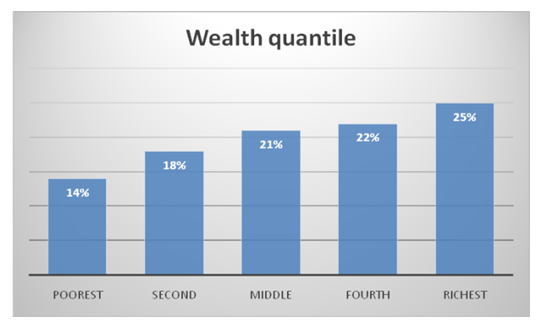 | Figure 3. The Wealth category of the enrolled students in lower secondary level education |
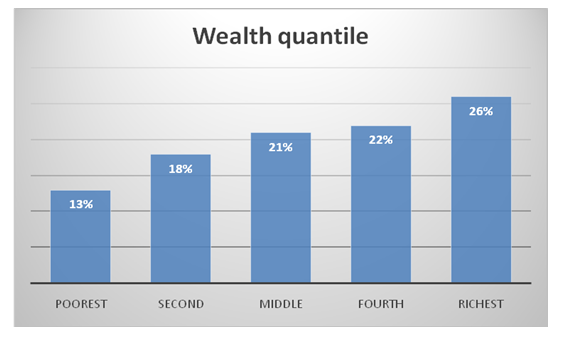 | Figure 4. The wealth quantile of the completed lower secondary students |
 | Figure 5. Students’ residential status in the lower secondary level education |
 | Figure 6. Students’ residential status of the completed lower secondary level education |
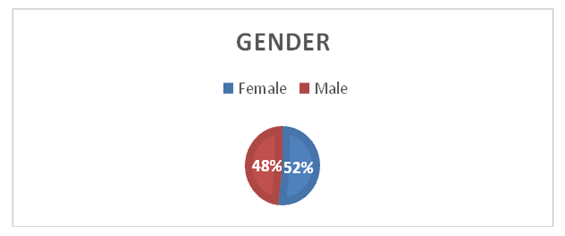 | Figure 7. Gender in the higher secondary education |
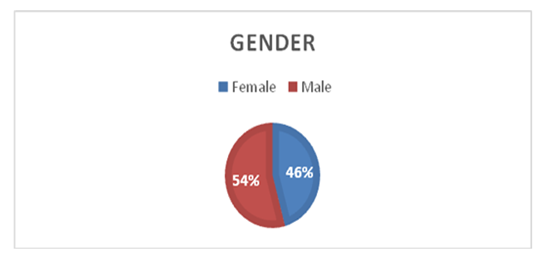 | Figure 8. Gender in the completed higher secondary education |
 | Figure 9. Wealth quintile of the higher secondary education students’ |
 | Figure 10. Wealth quintile of the completed higher secondary education students |
 | Figure 11. Higher secondary education students’ residence |
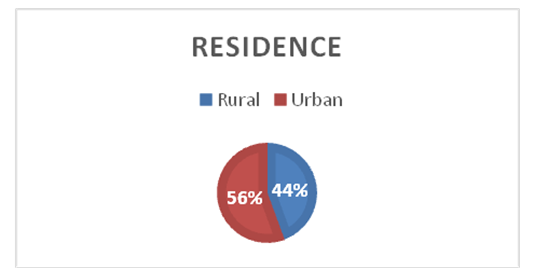 | Figure 12. Higher secondary education completed students’ residence |
5. Findings and Discussion
- The main aim of this study was to examine the current situation of teenagers’ education with the view lower secondary and higher secondary education particularly socio-economic perspective in Bangladesh. From the above data analysis, findings and discussion are given bellow. Here comparison was done between the students those who enrolled and completed their education in the lower and higher secondary education level. In the lower secondary level education enrollment rate of female students is higher than male students. At the same time it was also found that completed rate of female students is higher compare to male students. These findings shown that the number of completion of male students are decreasing with the comparison to enrolled students. On the other hand, it found that 48% male and 52% female students had enrolled into higher secondary level respectively. From the above findings, it shows that number of female students of completion is lower than enrolled rate. According to the UNICEF about 30.7% percent teenagers are out of school in junior secondary level (UNICEF, 2014).Now a days wealth is important factors for ensuring education. From this study finds that richest students completion rate is higher than poorest students in the lower secondary students. During enrolment the richest people rate was 25% but when they have completed the rate is 26%. On the other hand poor students enrollment rate was 14% but they completed their lower secondary education is 13%. These findings reveled that due to the lack of financial issue students of this level are deprived from education. In the case of higher secondary level education, the richest people completion rate is higher than the poorest people. During the enrollment, 20% poorest people were found but their completion rate is 9% only. Which is really very sorrow figure. At the same time 17% richest people enrolled in the higher secondary level students but their completion rate is 35%. With the comparison of poor people the richest peoples’ completion rate is high. The Bangladeshi teenagers are living and working on the streets and they are mostly vulnerable and exploited group of children (CAMPE, 2005). Kamrul et el. (2011) shown that drop out is decreasing but it is a significant issue right now for the teenagers. Those teenagers lives in the street they do not get sufficient food at all. Due to this poor nutrition in the early years has far reaching effect on children’s later school outcomes primary its effects on cognitive development (Abadzi, 2006). Our study is also able to find out the same correlation with the mentioned study’s findings.Our study’s one of the major objectives to find out the socio-economic condition is residential status of the lower and higher secondary level education. Here 48% rural and 52% urban people enrolled in the lower secondary education but their completion rate is different to enrolled. In the completion rate of rural area is 49% and urban area rate is 51% respectively. This rate shows that urban area’s students completed rate is more than the rural area students’ in lower secondary students. As a result the students are getting involved in different types of jobs. Kamrul et el. (2011) also shows that some students are dealing with odd jobs as the means of income.From the data analysis, during the enrollment urban area and rural area students at higher secondary were found same which is 50%. At the same time those who have completed their higher secondary education they are mostly reside in urban area which is 56% (UNICEF, 2003) also found this rate is positive in line for the urban area. Still more than 33% teenagers are drooping out from the school (UNICEF, 2017). As per the Bangladesh marriage law the marital age for the girl is 18 years and for boy is 21 years old. But early marriage is now a problematic issue. The gap between urban and rural areas is growing in various sides especially social-economical. Some impact goes on to the teenagers. They are depriving different types of service and opportunities due to these reasons. From the above findings and discussion, it seems like that the gender parity in enrolment; the gap is day by day decreasing in teenagers’ education. It is also a significant cause of backward of girls in these levels of education. When a girl marries, she usually drops out of school and begins full-time work in home.
6. Limitations of the Study
- This study undertook to examine the current situation socio-economic scenario of the teenagers education with view of lower secondary education and higher secondary education in Bangladesh. If the researchers would be able to collect data from different schools that was primary sources of data. From the primary data, more realistic situation would come out in these levels. As a result this outcome might more accept to the stakeholders. More variables and experimental design could be applied as to know the result from the various aspects. Only percentage of data is shown here.
7. Conclusions
- The present study showed small amount of variables on socio-economic status of lower secondary education and higher secondary education on teenager’s education in Bangladesh. From this study in particular ideas on teenager’s education could be very beneficial in the field of education. Since the secondary education is very important to show the real situation of teenager’s education, it is logical to explore more variables to validate these findings. Therefore, further study is recommended towards developing a better understanding of teenagers education in Bangladesh.
Conflicts of Interest
- No potential conflict of interest was reported by the author(s).
ACKNOWLEDEGMENTS
- We would like to acknowledge at first to the UNICEF authority to keep the data as open source and using their data in this research.
 Abstract
Abstract Reference
Reference Full-Text PDF
Full-Text PDF Full-text HTML
Full-text HTML